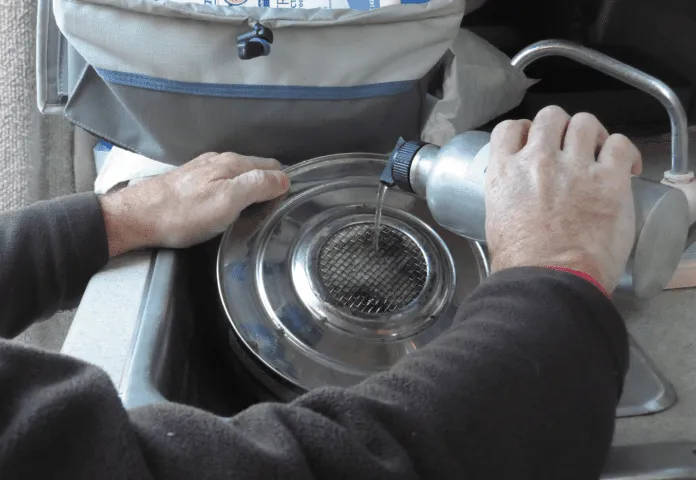By law, ethanol is subject to considerable taxes and restrictions on sale unless denatured (rendered undrinkable) by adding solvents or other unpalatable ingredients. The list of ingredients used for denaturing is long and contains many toxic solvents, including acetone, benzaldehyde, n-butyl alcohol, methyl isobutyl ketone, and gasoline. It’s no surprise then that the denatured alcohol that we buy in the paint department to burn in our alcohol stove stinks and sometimes burns with an odor; it’s formulated as a solvent, not as a fuel. These denatured alcohol blends can contain as little as 50-percent ethanol, with the balance most often being methanol.
Fuel for boat stoves is a tiny market, so although some fuels are nominally designated for marine use, this is usually a product aimed at another market that has been repackaged and marked with a higher price. Some smell bad, some don’t. Fortunately, the rules allow for the sale of other denatured alcohols formulated for specific markets that have demands similar to our own. The rising popularity of ethanol fireplaces has recently led to the introduction of new blends that don’t stink and provide a more luminous flame. As it turns out, many of these formulas also work well with alcohol stoves on boats.
A few years ago, in cooperation with federal regulators, the gas fireplace industry settled on a generic formula (known as 3C) and several other related formulas. The formula generally includes about 90 percent ethanol, 5-10 percent of either methanol or isopropanol, 10 parts per million of denatonium benzoate (Bitrex) and occasionally, ethyl acetate. The Bitrex, which tastes awful, helps deter people from drinking it.

Most hardware store denatured alcohol contains 50 percent ethanol and 50 percent methanol. Methanol has 20 percent less heating value than ethanol, and a stove burning this 50/50 blend produces 10 percent less heat and takes 10 percent longer to boil water than a stove burning a fuel containing 90 percent ethanol or more. If you want faster cook times, choose the fuel with the highest ethanol content.
Ethanol produces a more visible flame than methanol, and it also produces more soot on the bottom of your pans. Isopropyl is even more luminous and produces even more soot. We tested characteristics of various fuels in crucibles to make certain the soot, smell, and other side effects weren’t linked to contaminations in our stove reservoirs. In general, the more luminous the flame, the more soot we found on the pots.
This doesn’t mean you’ll experience more smoke or soot in the cabin while burning ethanol, but you will notice it on the pots. As a result, the flames produced by products like Klean Strip Green and Regal Premium Fireplace Fuel are much easier to see and generate 10 percent more heat, but also blacken pots. There’s always a trade-off, it seems.

The International Standards Organization (ISO) and the U.S. Environmental Protection Agency (EPA), carried out extensive tests using C3 fuel on the newer Cleancook stove, which has the same fuel reservoir as an Origo alcohol stove but with a slightly different top. Testers from both organizations gave the stoves excellent marks for clean burning, rivaling propane.
Sailors have reported slight headaches if the stove was operated using high-methanol fuels for long periods in areas with poor ventilation. Ethanol fuels also produced some odor, but no headaches. During our testing, we did not detect carbon monoxide while using any blend, so the cause for headaches is uncertain.
However, since the odor persisted only when there was a pot on the flame, and the headaches were linked only to methanol products, we suspect it has something to do with the relatively cold surface of the pot quenching the flame and producing formaldehyde. Testing has shown that burning 100 percent methanol in a space with poor ventilation can produce formaldehyde. The total amount of formaldehyde generated is not a serious health risk (it is about the same amount that was common in mobile homes before the rules restricted the use of polyurethane foam in their construction), but it may explain the headaches.

Not all foul tasting substances will deter people from using untaxed and often subsidized cooking fuel for their own personal booze trade; Bitrex, for example, has a high boiling point and can be separated from alcohol by distillation. For this reason, some of the denaturants must be close to ethanol in boiling point, so they can’t be removed by fractional distillation. The only denaturant we found that might accumulate in the reservoir in noticeable amounts was n-butanol which smells like rotten butter.
Although the small bottles are more expensive than half gallon cans you get at a hardware store, we find they are easier to use on a boat. If you want to save money, you can purchase the fuel in larger containers, transfer what you need into a pourable container designed for backpacking stove fuel. A liter bottle is just the right amount for a weekend sailing trip.
PRODUCTS
We tested a variety of fuels that can be used in alcohol stoves. We did not test any strong drinking alcohols, which would generally be more expensive. In a pinch, strong clear spirits, such as Everclear, can burn in an alcohol stove, but only work if it is 190 proof (95 percent alcohol).
FIREPLACE FUELS
The high ethanol content of fireplace fuels produces a more luminous flame, more heat, and leaves some soot on your pots. Because fireplace fuels come in one-liter bottles you’ll pay more for them than the hardware store blends, but if you buy the fireplace fuel by the case, the added expense isn’t that great. The advantage of these bottles is that they are designed to pour without spilling; some even include protections against flash-back if poured on an open flame. Despite these protections, never attempt to pour any fuel until you’ve let the stove cool completely.
E-NRG
The label describes the product as 100 percent ethanol, with only trace Bitrex for denaturing. The formula adds up to more than 100 percent volume (a physical impossibility), but that’s marketing for you. Whatever the actual blend is, it is very clean burning.
Bottom line: Recommended.
REGAL FLAME PREMIUM FIREPLACE FUEL
Regal fireplace fuel is sold in quart bottles, contains a small amount of methanol, and is clean burning.
Bottom line: Recommended.
SMART FUEL BIOETHANOL
Smart Fuel is ethanol that is denatured with just a little isopropanol and a few parts per million of Bitrex. We also like the smart-pour bottles, with a simple flame arrestor molded into the spout to prevent flashback.
Bottom line: Recommended.
HARDWARE STORE ETHANOLS
Yes, hardware bought fuels are cheap, but the gallon cans are impossible to pour from without spilling. Most are formulated with 50 percent methanol, which results in lower heat output, and, in some people, headaches. On the positive side, your pots won’t become as sooty.
HEET GAS LINE ANTIFREEZE.
Formulated with methanol, Heet Gas has been suggested on some online forums for use with stoves. We can’t understand why. It smells strong, is expensive, and probably generates fumes we don’t want to breathe. We’re not even sure why hardware stores still sell it; if you are using e10 (or e15) gasoline, which most of us do, there is 10 percent alcohol in the gasoline, so you are already protected against freezing temperatures. Adding a few ounces more alcohol is not going to do a darn thing.
Bottom line: No thanks.
KLEAN STRIP XLS
This is perhaps the most common stove fuel. It’s a 50/50 blend of ethanol and methanol. It burns clean but not as hot as ethanol fuels. You’ll sacrifice heat efficiency over other fuels with more ethanol, but the price is right.
Bottom line: This is our Budget Buy and the product we use on our own boat.
JASCO DENATURED ALCOHOL
Jasco brand is also commonly sold in hardware stores; it is very similar to Klean Strip XLS.
Bottom line: Recommended.
KLEAN STRIP GREEN
Primarily an ethanol fuel, Klean Strip is formulated with just 5 percent methanol and a trace of ethyl acetate as a denaturant. Like fireplace fuels, it gives more heat and produces a more luminous flame, but there will be some soot on the pots. The price is better than fireplace fuels, but the ethyl acetate denaturant gives it stronger odor when pouring (not when burning) and the 1-gallon can is less convenient.
Bottom line: This is another Budget Buy if you want to avoid methanol.
SUNNYSIDE DENATURED ALCOHOL
Sunnyside brand is also common in hardware stores. Another 50/50 blend of ethanol and methanol, it is very similar to Klean Strip XLS.
Bottom line: Budget Buy.
SEA FIT DENATURED ALCOHOL
Very similar to Klean Strip XLS, this is another ethanol/methanol blend. It’s a marine brand, so prices can run a little higher than hardware store blends.
Bottom line: Recommended.
CONCLUSION
Your stove will never be at its best with the wrong fuel. But which is the better choice; ethanol, with the hotter, more luminous flame, and fewer headaches, or methanol, with less soot and lower cost? We use the 50/50 blends to avoid soot and keep a hatch or portlight wide open. You might prefer the higher heat of a fireplace blend. Both are fine options. The best choice turns out to be a trade-off.
VALUE GUIDE: ETHANOL STOVE FUEL
CONTACTS
ENRG, e-nrg.com
HEET GAS, goldeagle.com
KLEAN STRIP, kleanstrip.com
REGAL FLAME, regalflame.com
SEAFIT, westmarine.com
SMART FUEL, Americanethanol.com
SUNNYSIDE, sunnysidecorp.com






































